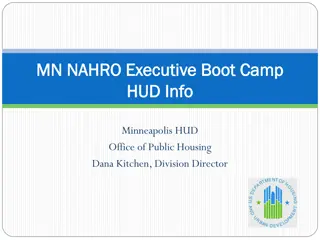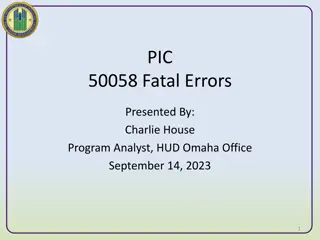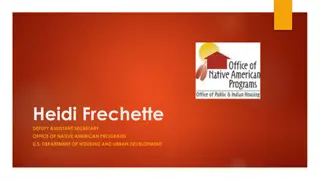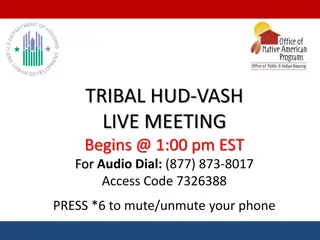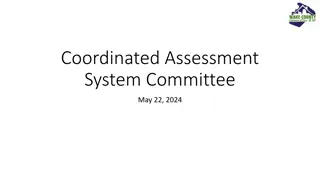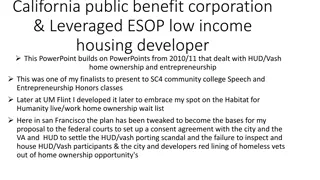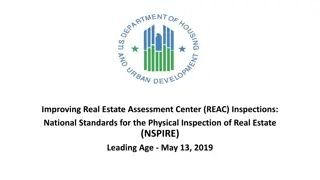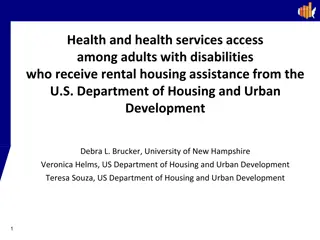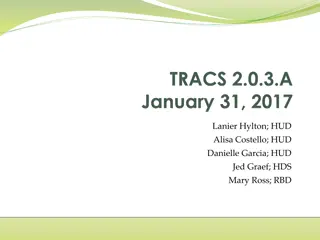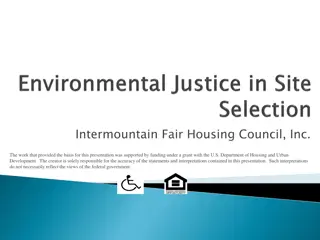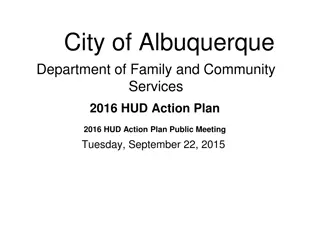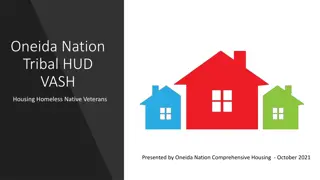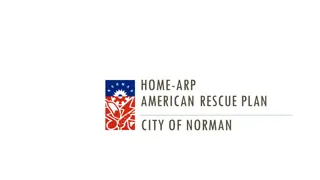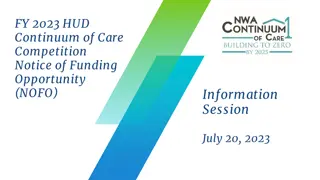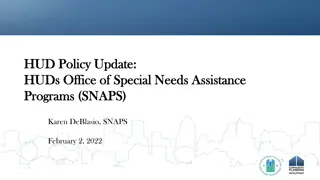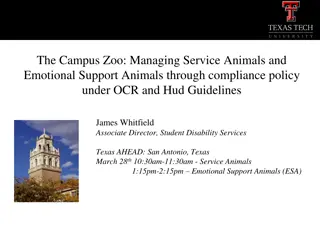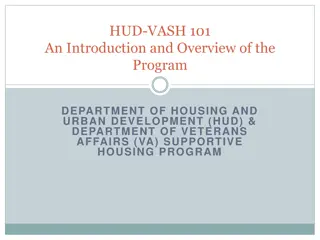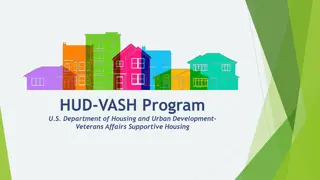HUD Programs and Initiatives Overview
Providing insights into U.S. Department of Housing & Urban Development programs such as ICDBG, Section 184 Indian Housing Loan Guarantee Program, Tribal HUD VASH Program, and audit submissions. Details on funding breakdowns, training, and evaluation processes are highlighted.
Download Presentation

Please find below an Image/Link to download the presentation.
The content on the website is provided AS IS for your information and personal use only. It may not be sold, licensed, or shared on other websites without obtaining consent from the author.If you encounter any issues during the download, it is possible that the publisher has removed the file from their server.
You are allowed to download the files provided on this website for personal or commercial use, subject to the condition that they are used lawfully. All files are the property of their respective owners.
The content on the website is provided AS IS for your information and personal use only. It may not be sold, licensed, or shared on other websites without obtaining consent from the author.
E N D
Presentation Transcript
U.S. Department of Housing & Urban Development 1 Eastern Woodlands Office of Native American Programs
ICDBG UPDATE 2 2016 ICDBG Funds: $60 Million Breakdown: $4.6 million for EWONAP 9 Tribes awarded in 2016; lowest score was 90. $4.9 Million for Imminent Threat (first come, first serve) ICDBG Grant Training: November 3, 2016 2017 ICDBG NOFA Training will be held in Chicago: Date TBD
Section 184 Indian Housing Loan Guarantee Program 3 Rapidly growing demand and more loan defaults have led to an overall increased risk to the 184 program. Such risk increases the operational cost of the program. As a result, effective December 1, 2016 the new annual premium of 0.25 percent of the remaining loan balance will apply to all new loan guarantees, including refinances.
TRIBAL HUD VETERANS ADMINISTRATION SUPPORTIVE HOUSING (VASH) DEMO PROGRAM 4 2015 Appropriations set aside $4 Million for a Tribal HUD VASH Pilot Program & HUD added another $2.1 million for a $6.1 million total. Four tribes were awarded Grants in the EWONAP area with one granted to the Lumbee Tribe of North Carolina. The President requested $7 million in his FY 2017 Budget. This was not voted on. GM Staff have been asked to report all VASH activity to HUD Headquarters on a weekly basis.
AUDIT SUBMISSIONS UPDATE External requests for copies of a Tribe s audits should be forwarded for consideration to the Federal Audit Clearinghouse website first, then to the Tribe/TDHE. 5 If a Tribe does not choose to release its audit, requestors can submit their request to HUD s FOIA Officer. The FOIA Coordinator will confirm with the Tribe whether they want to release the audits. Tribes are exempt from releasing their audits as outlined in 2 CFR 200.512(b)(2). Waivers for late audits are only allowable for matters completely beyond a Tribe or TDHE s ability to control. A Notice of Enforcement should be forwarded to the auditor to ensure that the deadlines are honored.
EWONAP Grant Evaluation Division 6 EWONAP evaluates and monitors each recipient s programs through the review of annual reports (APRs and ASERs), independent audits, and remote and on- site monitoring reviews. As necessary and required, ONAP initiates and manages capacity building actions for noncompliant recipient performance, as well as providing focused technical assistance. The overall goal of our monitoring and evaluation initiatives are to assist recipients in meeting the recipients program goals in compliance with specific program statutory and regulatory requirements.
ANNUAL PERFORMANCE REVIEWS (APRs) APRs require by sections 403(b) and 404(b) of NAHASDA, thus it is a statutory requirement and cannot be waived. The HUD/ONAP performance measures for recipient performance are set forth in 24 CFR 1000.524. 7 The Purpose of the APR is to: Ensure that the Tribe/TDHE has carried out its eligible activities in a timely manner in accordance with NAHASDA. Assess the compliance with the IHP of the Tribe/TDHE, and To determine whether the APR of the recipient is accurate. The APR Shall Contain: A comparison of actual accomplishments to the planned activities in the IHP annual plan. The reason(s) that the established planned activities were not accomplished. Analysis an explanation of cost overruns or high unit costs.
APRs (Continued) 8 Annual performance data reflecting accomplishments include but is not limited to: Permanent and temporary jobs supported with IHBG funds Outputs by eligible activity Units completed or assisted Families assisted Any outcome or program accomplishment from IHBG funds The APR must be submitted within 90 days of the end of the Tribe/TDHE s program year. If a justified request is submitted by the Tribe/TDHE, ONAP may extend the date for submission of the APR. This is a rare occurrence. The Tribe TDHE must make the report publically available to tribal members, non-Indians served under NAHASDA, and other citizens in the Indian area, in sufficient time before submission to HUD. ONAP shall respond to the APR within 60 days that all documents are submitted and the submission is deemed complete.
MONITORING 9 Monitoring is the means by which ONAP fulfills its public trust responsibilities. It is an integral management control technique and a U.S. Government Accountability Office standard. It is an ongoing process that assesses the quality of a recipient s performance over a period of time. Monitoring provides information about recipients that is critical for making informed judgments about program effectiveness and management efficiency and compliance with applicable laws and regulations.
MONITORING (Continued) 10 Monitoring is the principal means by which HUD: Ensures that programs are carried out efficiently, effectively, and in compliance with applicable laws and regulations; Assists recipients in improving performance, developing or increasing capacity, and augmenting its management and technical skills; Stays abreast of the efficacy of ONAP-administered programs within the communities these programs serve; Identifies, validates, and/or refines technical assistance needs, as defined in the risk assessment process; Collects data from recipients that helps HUD assess recipient risk; Initiates HUD actions that reinforce, improve, supplement, and correct recipient performance; and Identifies and analyzes patterns of recipient activity that indicate superior, satisfactory, and deficient performance, which then can be used to improve HUD programs and increase overall recipient success rates.
MONITORING (Cont d) 11 Grant Programs Subject to ONAP Monitoring are: Indian Housing Block Grant (IHBG) Indian Community Development Block Grant (ICDBG) Resident Opportunities and Self Sufficiency (ROSS) Rural Housing and Economic Development, as of FY 2010 known as the Rural Innovation Fund (RHED/RIF) Transitional programs that remain from the U.S. Housing Act of 1937
Contact Information 12 U.S. Department of Housing and Urban Development Eastern Woodlands Office of Native American Programs 77 W. Jackson Boulevard, 24th Floor Chicago, IL 60604 800.735.3239 Mark Butterfield Administrator Mark.Butterfield@hud.gov 312-913-8750 William Dawson, III Director, Grants Evaluation William.O.Dawson.III@hud.gov


